Taylor D.A. Introduction to marine engineering
Подождите немного. Документ загружается.

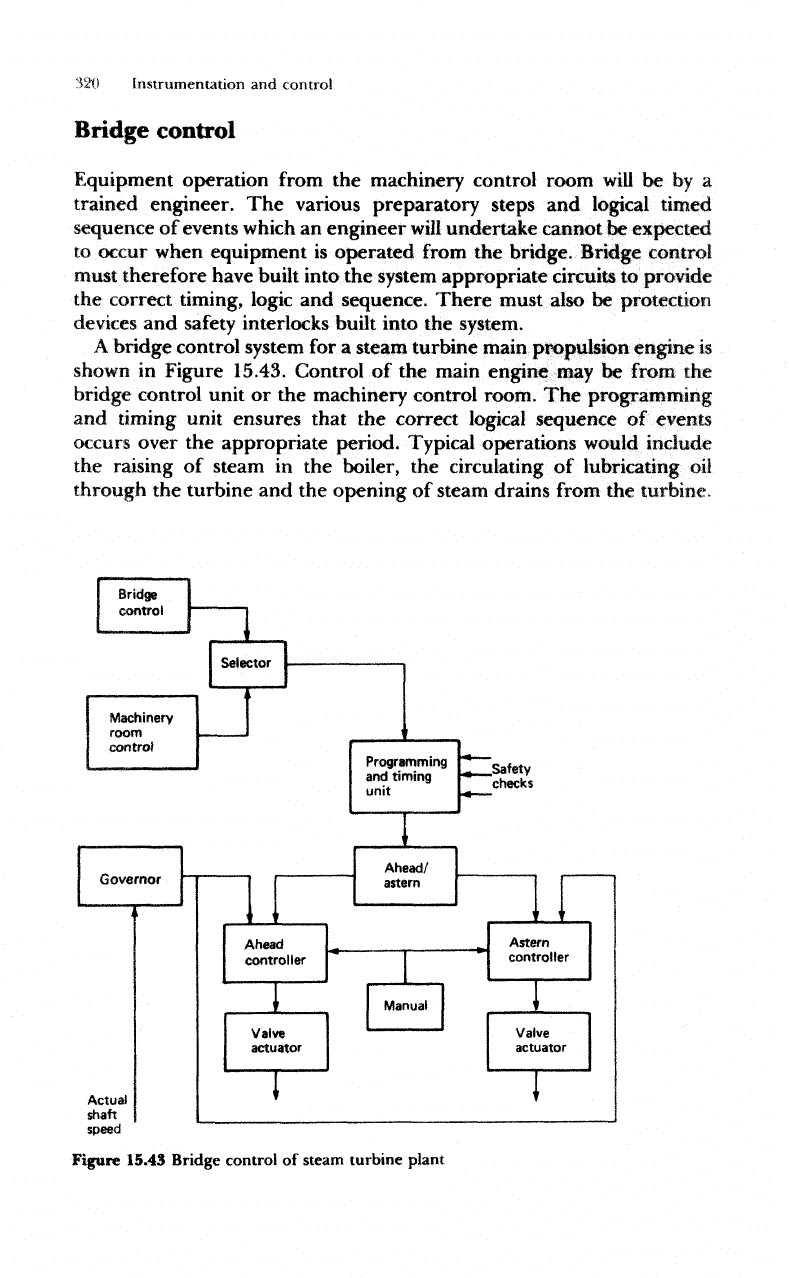
320
Instrumentation
and
control
Bridge control
Equipment
operation
from
the
machinery control room
will
be by a
trained engineer.
The
various preparatory steps
and
logical timed
sequence
of
events
which
an
engineer
will
undertake cannot
be
expected
to
occur
when
equipment,
is
operated
from
the
bridge.
Bridge control
must
therefore have
built
into
the
system appropriate
circuits
to
provide
the
correct timing, logic
and
sequence.
There
must also
be
protection
devices
and
safety
interlocks built into
the
system.
A
bridge
control system
for a
steam turbine
main
propulsion
engine
is
shown
in
Figure 15.43. Control
of the
main engine
may be
from
the
bridge control unit
or the
machinery control room.
The
programming
and
timing unit
ensures
that
the
correct
logical
sequence
of
events
occurs
over
the
appropriate period. Typical operations would include
the
raising
of
steam
in the
boiler,
the
circulating
of
lubricating
oil
through
the
turbine
and the
opening
of
steam drains
from
the
turbine.
Figure
15.43 Bridge control
of
steam turbine plant
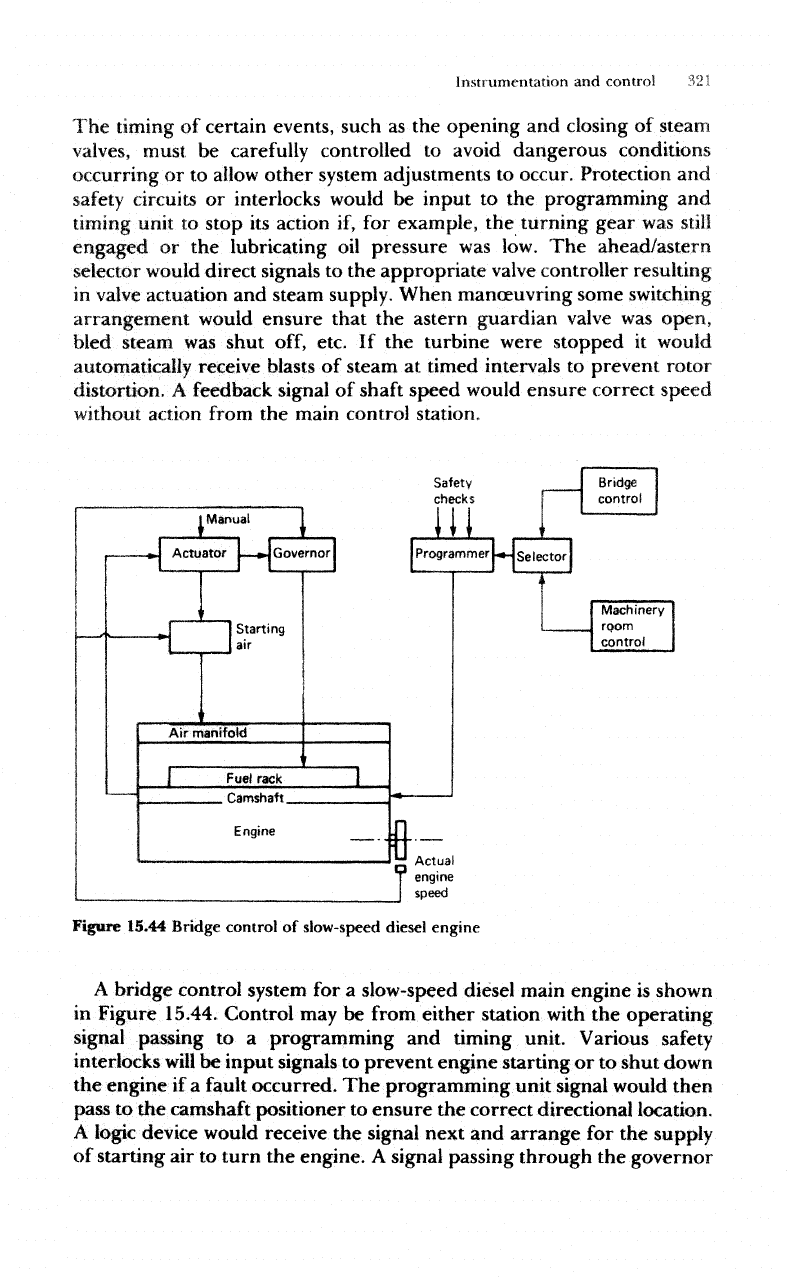
Instrumentation
and
control
32!
The
timing
of
certain events,
such
as the
opening
and
closing
of
steam
valves,
must
be
carefully
controlled
to
avoid
dangerous conditions
occurring
or to
allow
other
system
adjustments
to
occur. Protection
and
safety
circuits
or
interlocks would
be
input
to the
programming
and
timing
unit
to
stop
its
action
if, for
example,
the
turning gear
was
still
engaged
or the
lubricating
oil
pressure
was
low.
The
ahead/astern
selector
would
direct signals
to the
appropriate
valve
controller resulting
in
valve
actuation
and
steam supply. When
manoeuvring
some
switching
arrangement would ensure that
the
astern guardian
valve
was
open,
bled
steam
was
shut off, etc.
If the
turbine were stopped
it
would
automatically
receive
blasts
of
steam
at
timed
intervals
to
prevent rotor
distortion,
A
feedback signal
of
shaft
speed
would
ensure correct speed
without
action
from
the
main
control
station.
Safety
checks
Figure
15.44 Bridge control
of
slow-speed diesel engine
A
bridge control system
for a
slow-speed
diesel main engine
is
shown
in
Figure
15.44.
Control
may be
from
either station
with
the
operating
signal
passing
to a
programming
and
timing unit. Various
safety
interlocks
will
be
input signals
to
prevent engine starting
or to
shut down
the
engine
if a
fault
occurred.
The
programming unit signal would then
pass
to the
camshaft positioner
to
ensure
the
correct
directional location.
A
logic
device would receive
the
signal next
and
arrange
for the
supply
of
starting
air to
turn
the
engine.
A
signal passing through
the
governor
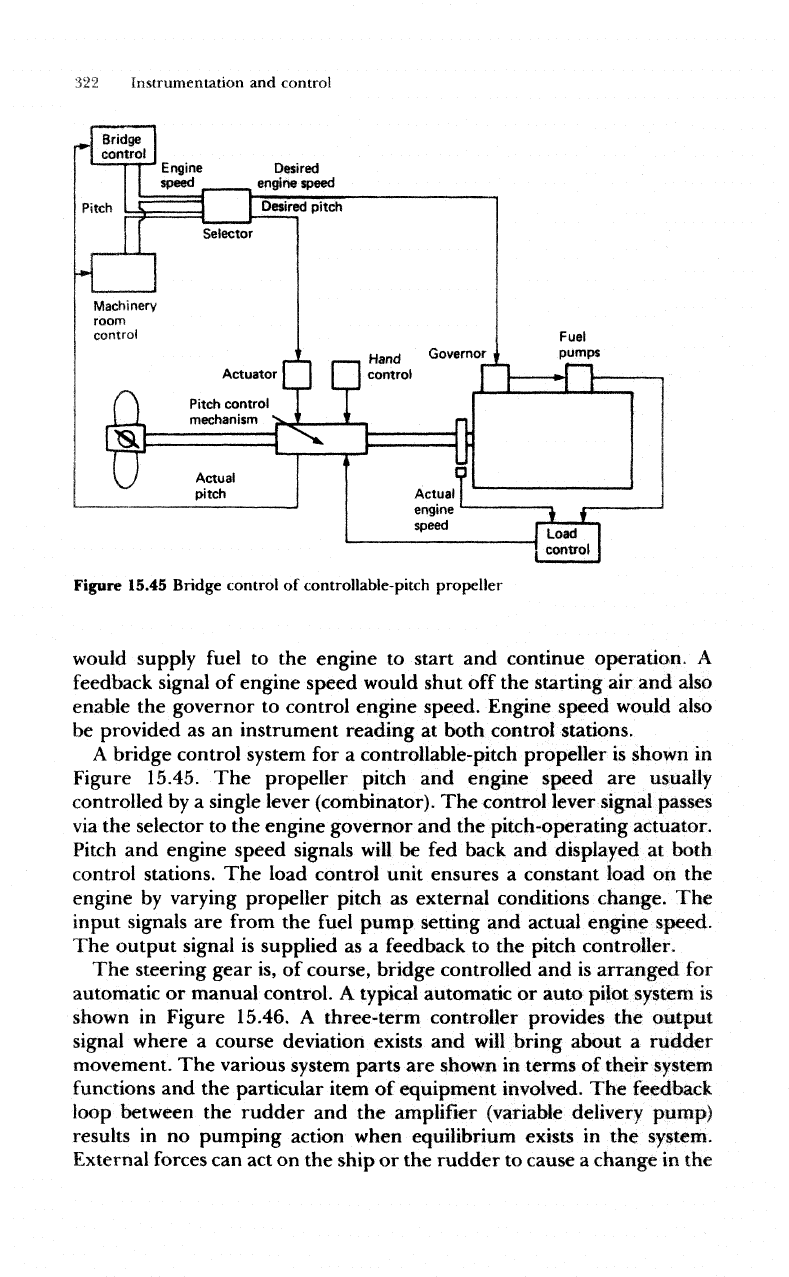
322
Instrumentation
and
control
Figure
15.45 Bridge control
of
controllable-pitch propeller
would
supply
fuel
to the
engine
to
start
and
continue operation.
A
feedback
signal
of
engine
speed
would shut
off the
starting
air and
also
enable
the
governor
to
control engine
speed.
Engine speed would also
be
provided
as an
instrument reading
at
both control stations.
A
bridge control system
for a
controllable-pitch
propeller
is
shown
in
Figure 15.45.
The
propeller pitch
and
engine
speed
are
usually
controlled
by a
single lever
(combinator).
The
control lever signal passes
via
the
selector
to the
engine governor
and the
pitch-operating actuator.
Pitch
and
engine
speed
signals
will
be fed
back
and
displayed
at
both
control
stations.
The
load control unit ensures
a
constant
load
on the
engine
by
varying propeller pitch
as
external conditions change.
The
input signals
are
from
the
fuel
pump setting
and
actual engine
speed.
The
output signal
is
supplied
as a
feedback
to the
pitch controller.
The
steering gear
is, of
course, bridge controlled
and is
arranged
for
automatic
or
manual control.
A
typical automatic
or
auto
pilot system
is
shown
in
Figure 15.46.
A
three-term controller provides
the
output
signal
where
a
course deviation exists
and
will
bring about
a
rudder
movement.
The
various system parts
are
shown
in
terms
of
their
system
functions
and the
particular
item
of
equipment involved.
The
feedback
loop between
the
rudder
and the
amplifier (variable delivery pump)
results
in no
pumping action when equilibrium exists
in the
system.
External
forces
can act on the
ship
or the
rudder
to
cause
a
change
in the
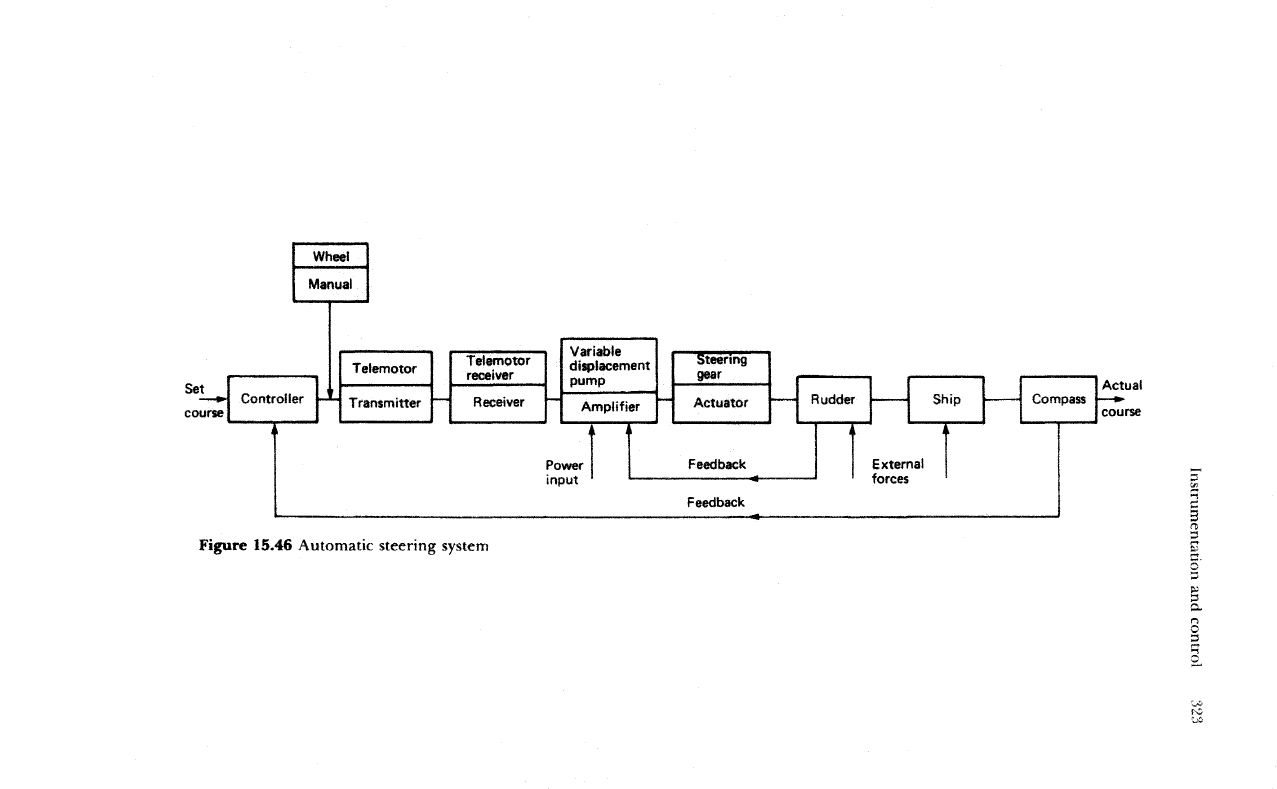
Set
—*•
course
Controller
i
Telemotor
"
Transmitter
Telemotor
receiver
Receiver
Variable
displacement
pump
Amplifier
i
Power
input
i
i
Steering
gear
Actuator
Rudder
Feedback
I'.
..
i
....
i
^
j
/
•
Ship
t
Compass
External
forces
Feedback
Actual
—•»
course
Figure
15.46
Automatic steering system
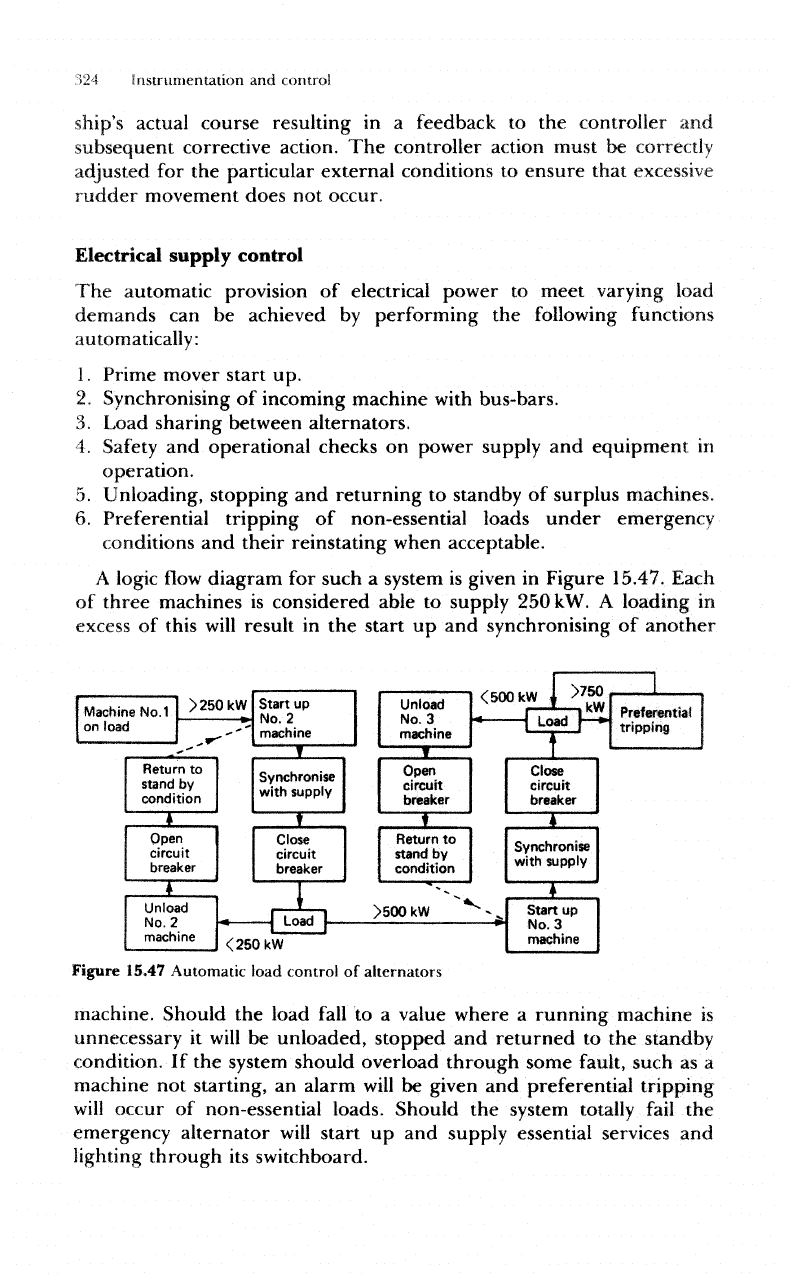
Instrumentation
and
control
ship's
actual course resulting
in
a
feedback
to the
controller
and
subsequent corrective action.
The
controller action must
be
correctly
adjusted
for the
particular
external
conditions
to
ensure that excessive
rudder movement does
not
occur.
Electrical
supply
control
The
automatic provision
of
electrical power
to
meet
varying
load
demands
can be
achieved
by
performing
the
following
functions
automatically:
1.
Prime mover start
up.
2.
Synchronising
of
incoming machine
with
bus-bars.
3.
Load sharing between alternators,
4.
Safety
and
operational checks
on
power supply
and
equipment
in
operation.
5.
Unloading, stopping
and
returning
to
standby
of
surplus machines.
6.
Preferential tripping
of
non-essential loads
under
emergency
conditions
and
their reinstating when acceptable.
A
logic
flow
diagram
for
such
a
system
is
given
in
Figure 15.47. Each
of
three
machines
is
considered
able
to
supply
250
kW. A
loading
in
excess
of
this
will
result
in the
start
up and
synchronising
of
another
Machine
No.1
on
load
....
,
r*'
>250kW
1
»»
^v"
*•"
Return
to
stand
by
condition
t
Open
circuit
breaker
t
Unload
No. 2
machine
Start
up
No. 2
machine
T
Synchronise
with
supply
'
1
Close
circuit
breaker
«
JLo
<250kW
Unload
No. 3
machine
•
Open
circuit
breaker
»
Return
to
stand
by
condition
<500kW
,
«
j
Lo
I
'-v
\-—\
>500
kW
*^
-
„
ad
1
—
»•
>750,
1
.
.
|kW
Preferential
2r!,,J
tripping
Close
circuit
breaker
'
•
Synchronise
with
supply
'
\
Start
up
No. 3
machine
Figure 15,47
Automatic
load control
of
alternators
machine.
Should
the
load
fall
to a
value where
a
running machine
is
unnecessary
it
will
be
unloaded,
stopped
and
returned
to the
standby
condition.
If the
system should overload through some
fault,
such
as a
machine
not
starting,
an
alarm
will
be
given
and
preferential tripping
will
occur
of
non-essential loads. Should
the
system totally
fail
the
emergency alternator
will
start
up and
supply essential services
and
lighting
through
its
switchboard.
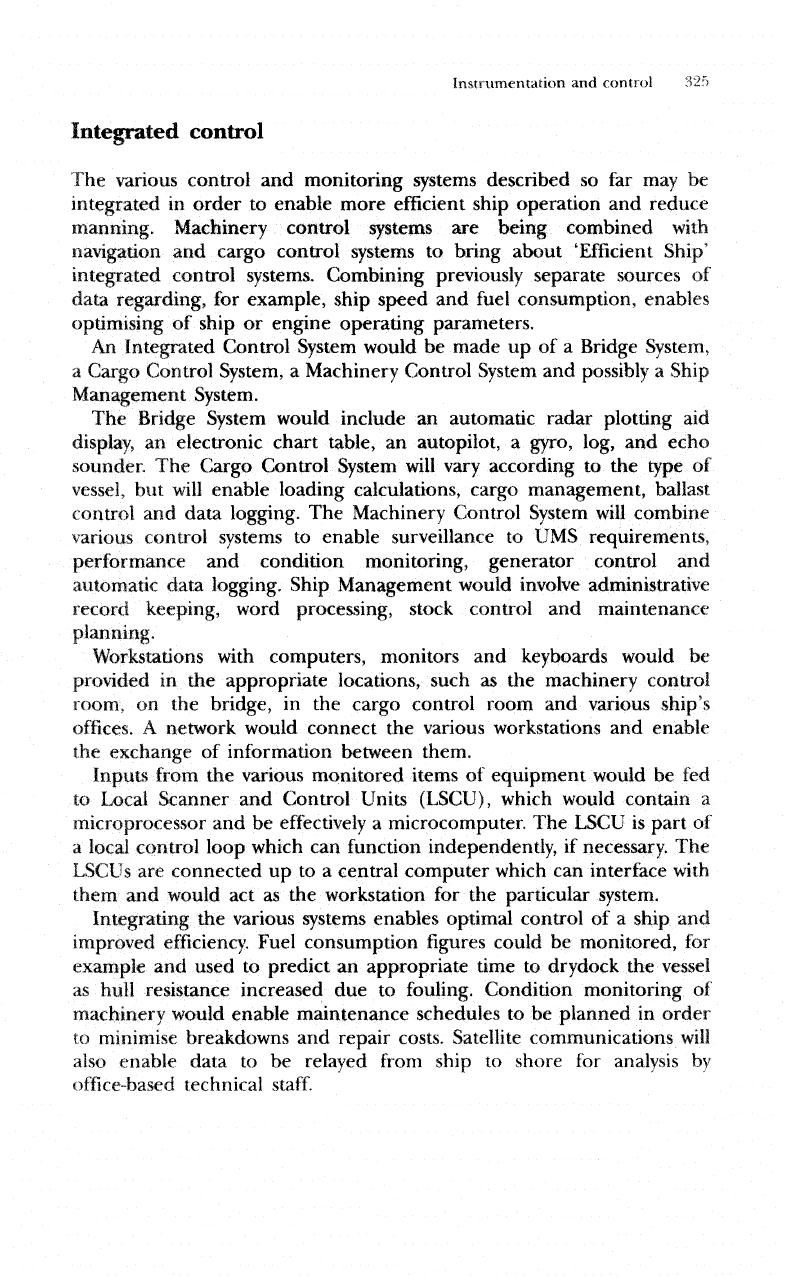
Instrumentation
and
control
325
Integrated
control
The
various control
and
monitoring systems described
so far may be
integrated
in
order
to
enable more
efficient
ship operation
and
reduce
manning.
Machinery
control
systems
are
being
combined
with
navigation
and
cargo
control
systems
to
bring about
'Efficient
Ship'
integrated control systems. Combining previously separate sources
of
data regarding,
for
example, ship
speed
and
fuel
consumption, enables
optimising
of
ship
or
engine
operating
parameters,
An
Integrated Control System would
be
made
up of a
Bridge System,
a
Cargo
Control
System,
a
Machinery Control System
and
possibly
a
Ship
Management System.
The
Bridge System would include
an
automatic radar plotting
aid
display,
an
electronic chart table,
an
autopilot,
a
gyro,
log,
and
echo
sounder.
The
Cargo Control System
will
vary according
to the
type
of
vessel,
but
will
enable loading calculations, cargo management, ballast
control
and
data logging.
The
Machinery Control System
will
combine
various
control systems
to
enable surveillance
to UMS
requirements,
performance
and
condition monitoring, generator control
and
automatic
data logging. Ship Management would involve administrative
record keeping, word processing, stock control
and
maintenance
planning.
Workstations
with
computers, monitors
and
keyboards would
be
provided
in the
appropriate locations, such
as the
machinery control
room,,
on the
bridge,
in the
cargo control room
and
various ship's
offices.
A
network would connect
the
various workstations
and
enable
the
exchange
of
information between them,
Inputs
from
the
various monitored items
of
equipment would
be fed
to
Local Scanner
and
Control Units
(LSCU),
which
would contain
a
microprocessor
and be
effectively
a
microcomputer.
The
LSCU
is
part
of
a
local control loop which
can
function independently,
if
necessary.
The
LSCUs
are
connected
up to a
central computer
which
can
interface
with
them
and
would
act as the
workstation
for the
particular system.
Integrating
the
various systems enables optimal control
of a
ship
and
improved
efficiency.
Fuel consumption
figures
could
be
monitored,
for
example
and
used
to
predict
an
appropriate time
to
drydock
the
vessel
as
hull resistance increased
due to
fouling. Condition monitoring
of
machinery
would enable maintenance schedules
to be
planned
in
order
to
minimise breakdowns
and
repair costs. Satellite communications
will
also
enable data
to be
relayed
from
ship
to
shore
for
analysis
by
office-based
technical
staff.
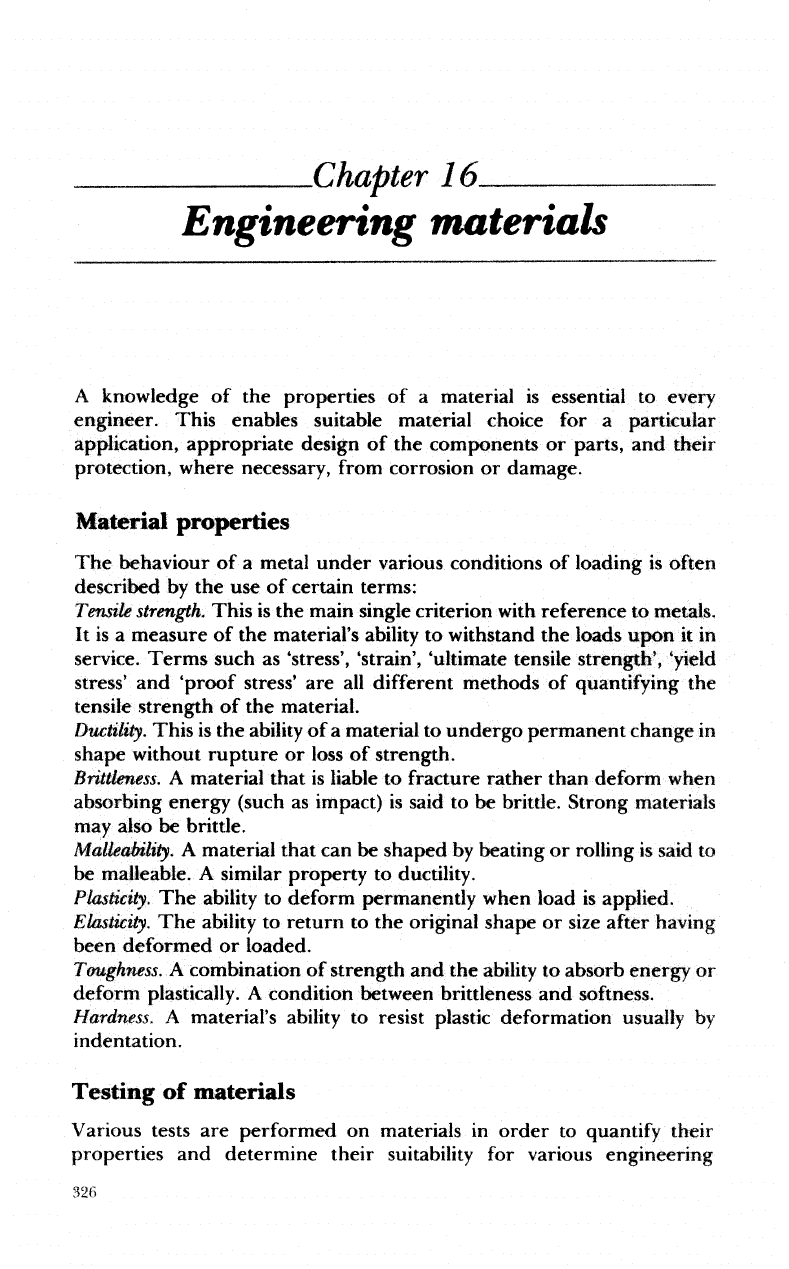
A
knowledge
of the
properties
of a
material
is
essential
to
every
engineer.
This
enables suitable material choice
for a
particular
application,
appropriate
design
of the
components
or
parts,
and
their
protection, where necessary,
from
corrosion
or
damage.
Material
properties
The
behaviour
of a
metal
under
various conditions
of
loading
is
often
described
by the use of
certain terms:
Tensile
strength.
This
is the
main single criterion
with
reference
to
metals.
It
is a
measure
of the
material's ability
to
withstand
the
loads upon
it in
service.
Terms
such
as
'stress',
'strain',
'ultimate
tensile
strength*,
'yield
stress'
and
'proof
stress'
are all
different methods
of
quantifying
the
tensile
strength
of the
material.
Ductility,
This
is the
ability
of a
material
to
undergo permanent change
in
shape without rupture
or
loss
of
strength.
Brittleness,
A
material that
is
liable
to
fracture rather than deform
when
absorbing energy (such
as
impact)
is
said
to be
brittle. Strong materials
may
also
be
brittle.
Malleability.
A
material that
can be
shaped
by
beating
or
rolling
is
said
to
be
malleable.
A
similar property
to
ductility.
Plasticity.
The
ability
to
deform permanently when load
is
applied.
Elasticity.
The
ability
to
return
to the
original shape
or
size after having
been deformed
or
loaded.
Toughness.
A
combination
of
strength
and the
ability
to
absorb energy
or
deform
plastically.
A
condition between brittleness
and
softness.
Hardness.
A
material's
ability
to
resist plastic deformation
usually
by
indentation.
Testing
of
materials
Various
tests
are
performed
on
materials
in
order
to
quantify
their
properties
and
determine their
suitability
for
various engineering
Chapter
16
Engineering materials
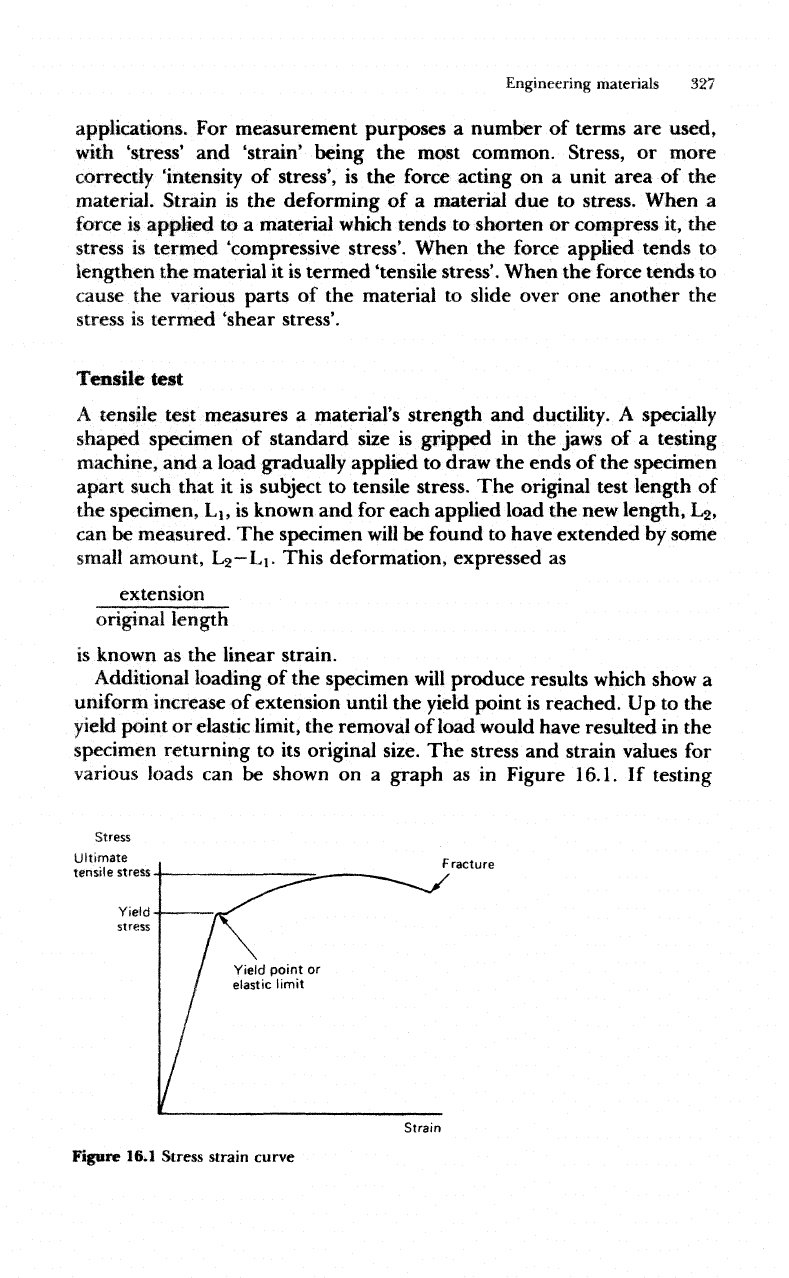
Engineering
materials
327
applications.
For
measurement
purposes
a
number
of
terms
are
used,
with
'stress'
and
'strain'
being
the
most common. Stress,
or
more
correctly
"intensity
of
stress',
is the
force acting
on a
unit area
of the
material. Strain
is the
deforming
of a
material
due to
stress. When
a
force
is
applied
to a
material
which
tends
to
shorten
or
compress
it, the
stress
is
termed
'compressive
stress'.
When
the
force applied tends
to
lengthen
the
material
it is
termed
'tensile
stress'.
When
the
force
tends
to
cause
the
various parts
of the
material
to
slide over
one
another
the
stress
is
termed
'shear
stress'.
Tensile
test
A
tensile test measures
a
material's strength
and
ductility.
A
specially
shaped specimen
of
standard size
is
gripped
in the
jaws
of a
testing
machine,
and a
load gradually
applied
to
draw
the
ends
of the
specimen
apart such that
it is
subject
to
tensile stress.
The
original test length
of
the
specimen,
LI,
is
known
and for
each applied load
the new
length,
L-2,
can
be
measured.
The
specimen
will
be
found
to
have extended
by
some
small
amount,
Lg—LI.
This deformation, expressed
as
extension
original
length
is
known
as the
linear strain.
Additional loading
of the
specimen
will
produce
results which show
a
uniform
increase
of
extension until
the
yield point
is
reached.
Up to the
yield
point
or
elastic
limit,
the
removal
of
load would have resulted
in the
specimen
returning
to its
original size.
The
stress
and
strain values
for
various
loads
can be
shown
on a
graph
as in
Figure
16.1.
If
testing
Fracture
Strain
Figure
16.1 Stress
strain
curve
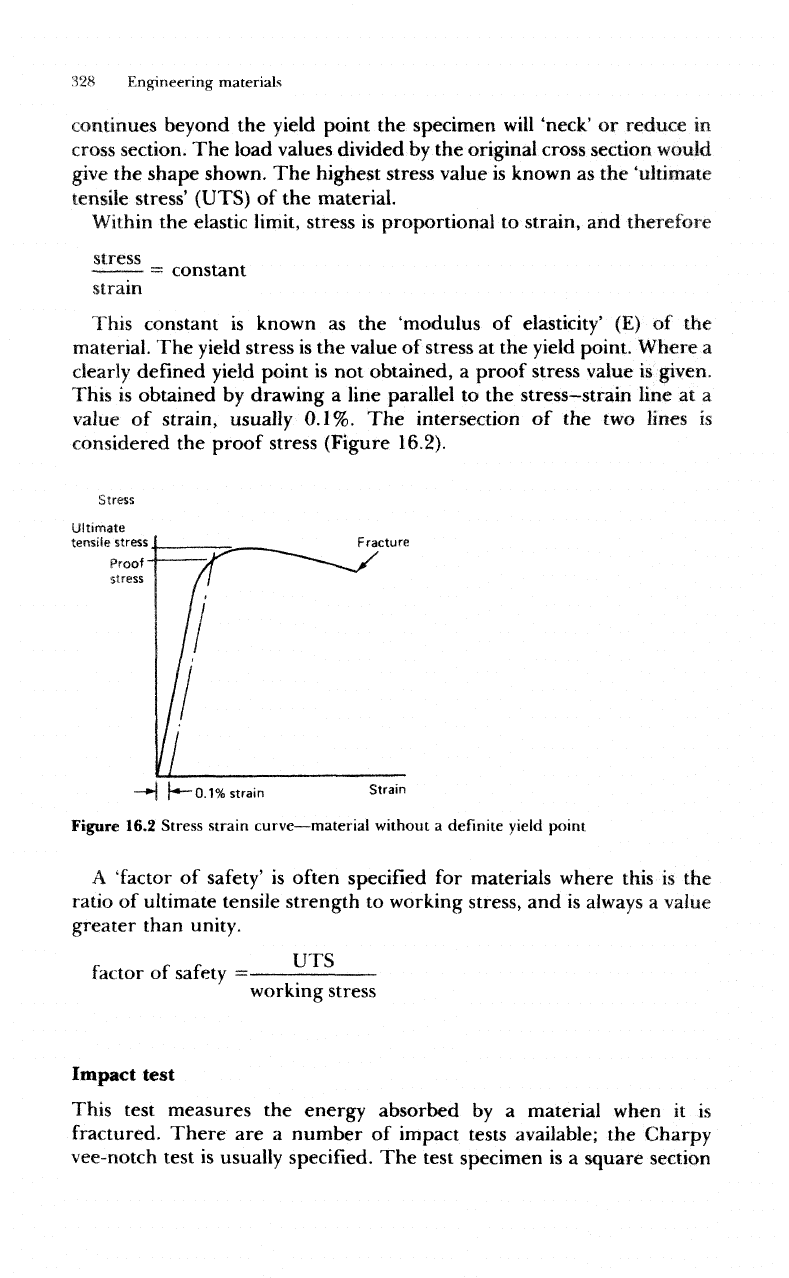
328
Engineering
materials
continues
beyond
the
yield point
the
specimen
will
'neck'
or
reduce
in
cross section.
The
load values divided
by the
original cross section would
give
the
shape
shown.
The
highest
stress
value
is
known
as the
'ultimate
tensile
stress'
(UTS)
of the
material.
Within
the
elastic
limit,
stress
is
proportional
to
strain,
and
therefore
stress
strain
=
constant
This
constant
is
known
as the
'modulus
of
elasticity*
(E) of the
material.
The
yield stress
is the
value
of
stress
at the
yield
point. Where
a
clearly
defined yield point
is not
obtained,
a
proof stress value
is
given.
This
is
obtained
by
drawing
a
line parallel
to the
stress—strain
line
at a
value
of
strain, usually
0.1%.
The
intersection
of the two
lines
is
considered
the
proof stress (Figure 16.2).
Stress
Fracture
—H
h*~0.1%
strain
Strain
Figure 16.2 Stress
strain
curve—material
without
a
definite
yield
point
A
'factor
of
safety'
is
often specified
for
materials where
this
is the
ratio
of
ultimate tensile strength
to
working stress,
and is
always
a
value
greater than
unity.
factor
of
safety
=
UTS
working
stress
Impact test
This test measures
the
energy absorbed
by a
material when
it is
fractured.
There
are a
number
of
impact tests available;
the
Charpy
vee-notch
test
is
usually
specified.
The
test specimen
is a
square section
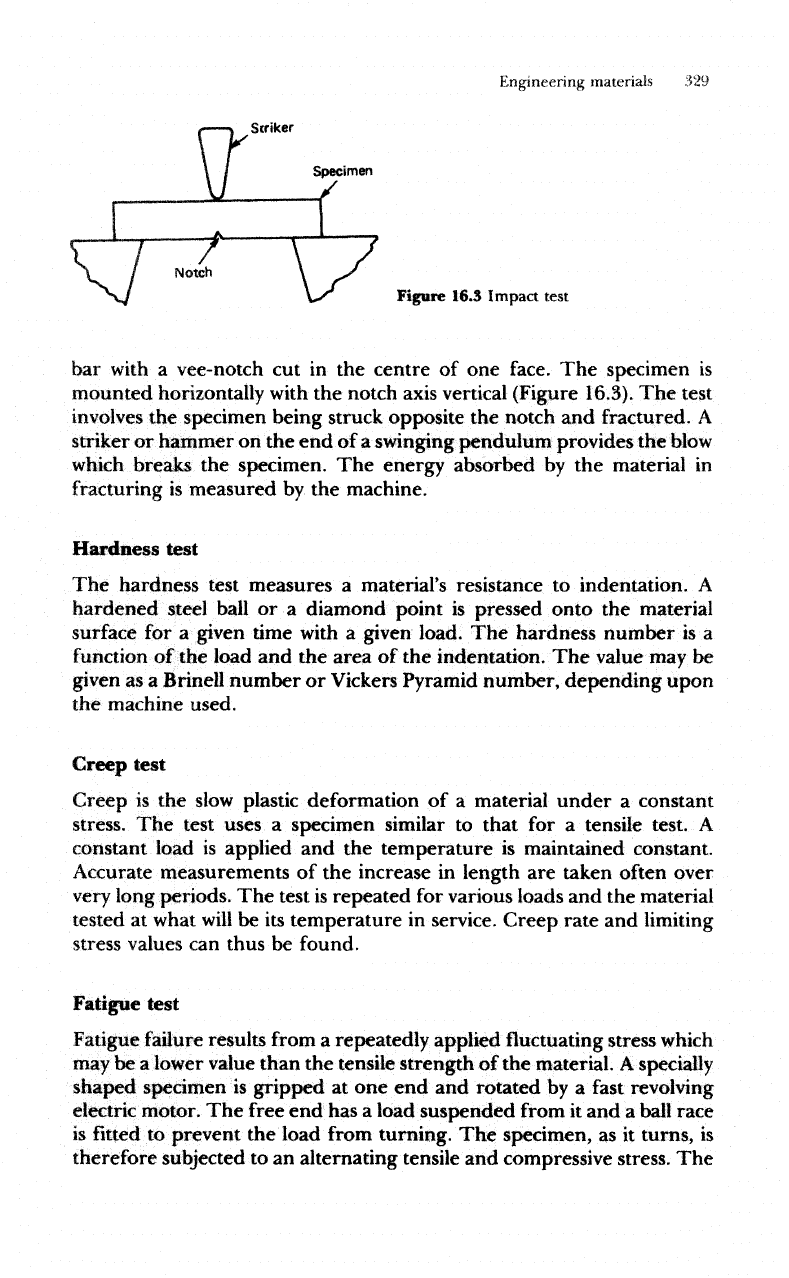
Engineering
materials
329
Figure
16.S Impact test
bar
with
a
vee-notch
cut in the
centre
of one
face.
The
specimen
is
mounted horizontally
with
the
notch axis vertical (Figure 16,3).
The
test
involves
the
specimen being struck
opposite
the
notch
and
fractured.
A
striker
or
hammer
on the end of a
swinging
pendulum
provides
the
blow
which
breaks
the
specimen.
The
energy absorbed
by the
material
in
fracturing
is
measured
by
the
machine.
The
hardness test measures
a
material's resistance
to
indentation.
A
hardened steel ball
or a
diamond point
is
pressed
onto
the
material
surface
for a
given time
with
a
given
load.
The
hardness number
is a
function
of
the
load
and the
area
of the
indentation.
The
value
may be
given
as a
Brinell number
or
Vickers Pyramid number, depending upon
the
machine used.
Creep
test
Creep
is the
slow
plastic deformation
of a
material under
a
constant
stress.
The
test uses
a
specimen similar
to
that
for a
tensile test.
A
constant
load
is
applied
and the
temperature
is
maintained constant.
Accurate
measurements
of the
increase
in
length
are
taken often over
very
long periods.
The
test
is
repeated
for
various loads
and the
material
tested
at
what
will
be its
temperature
in
service. Creep rate
and
limiting
stress values
can
thus
be
found.
Fatigue test
Fatigue failure
results
from
a
repeatedly
applied
fluctuating stress which
may
be a
lower value than
the
tensile strength
of the
material.
A
specially
shaped
specimen
is
gripped
at one end and
rotated
by a
fast
revolving
electric motor.
The
free
end
has a
load suspended from
it and a
ball
race
is
fitted to
prevent
the
load from turning.
The
specimen,
as it
turns,
is
therefore subjected
to an
alternating tensile
and
compressive
stress.
The
